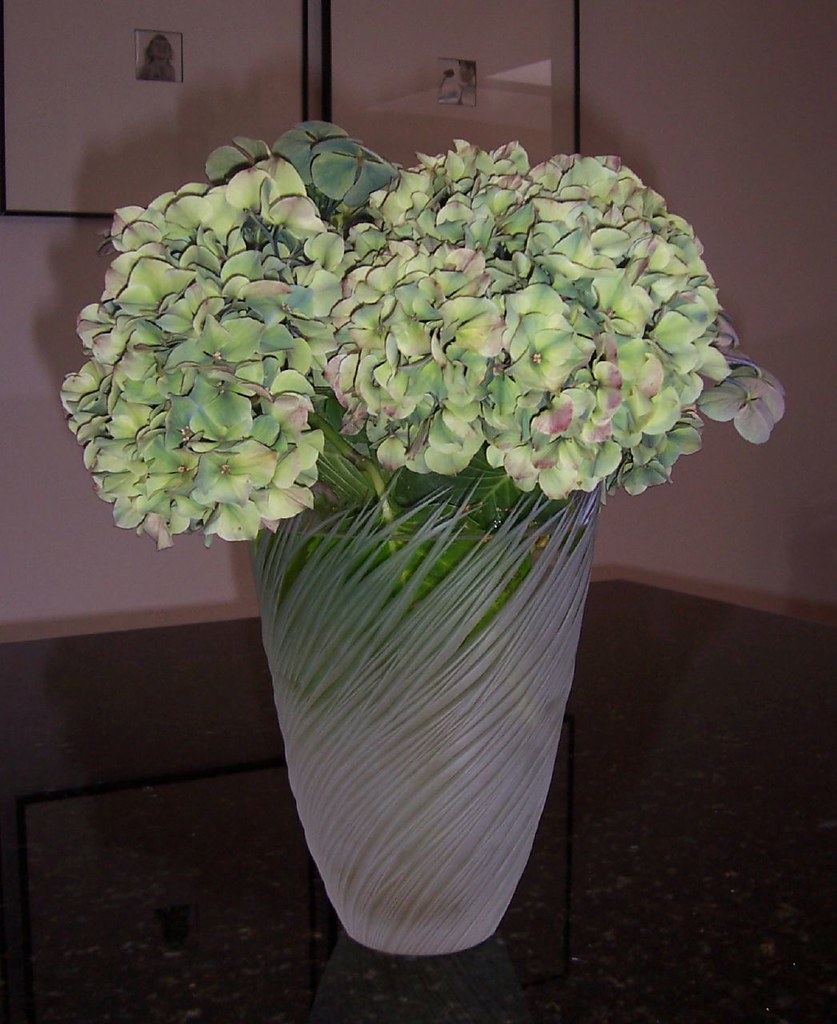|
What a wonderful gift I received this week! My partner in a weekly Bible study gave me a bouquet of lime-green hydrangeas cut from her garden. Hydrangeas are nostalgic flowers for me as they remind me of my grandmother's garden and a picture of me as a girl holding a bouquet of pink and blue hydrangeas.
I noticed that my friend cut the stems of the flowers at a 45-degree angle. This is one of the "tricks of the trade" that florists use to assure that the flower stem has maximum surface area to absorb water. Once a flower cutting is taken from the main plant, it will eventually die. The objective is to make the cut flower last as long as possible. Jesus told His disciples, "If you do not remain in me, you will be like a branch that is thrown away and withers...If you remain in me and my words remain in you, ask whatever you wish, and it will be done for you." (John 15:6-7) We, like a cut flower, will die if we disconnect from Jesus. Who doesn't enjoy having a beautiful bouquet of cut flowers in their home? Let's look at some of the other ways in which we can prolong the life of a cut flower, and how our lives in Christ Jesus can be refreshed and sustained. The right tool must be used to cut the stem of a flower. Regular scissors pinch the water channel of the stalk. A sharp knife or pruning shears should be the tool of choice. Also, cutting flowers under a steady flow of water keeps air pockets, that prevent water absorption, from forming. Stems should be plunged into a vase of clear, tepid water immediately after cutting according to The Old Farmer's Almanac. Jesus told the Samaritan woman that He met at Jacob's well that He is "living water." He said, "Whoever drinks the water I give them will never thirst. Indeed, the water I give them will become in them a spring of water welling up to eternal life." (John 4:14) We must be sure to drench ourselves in living water daily. To maintain longevity of cut flowers we must strip all leaves from the bottom part of the stem that would be under the water. Rotten plant material destroys the quality of the water. If the water becomes cloudy it means that bacteria is growing and can clog the stems. A splash of bleach in the water reduces the amount of bacteria in the water. It is also important to avoid placing a vase of flowers near fruit or vegetables since they give off ethylene gas which shortens the life of cut flowers. We too must not give the enemy of our souls access to our lives. We must say with the Psalmist, "But I trust in You, Lord; I say, 'You are my God.' My times are in your hands; deliver me from the hands of my enemies, from those who pursue me. Let your face shine on your servant; save me in your unfailing love." (Psalm 31:14-16) It is helpful to place a small amount of sugar in the water as it feeds the flowers. It is also wise to change and refresh the water every few days. In addition, it is recommended that about one inch of the stem bottom be removed every three or four days. This assures that the water continues to penetrate the stem. Let us remember what it says in Psalm 104:27. "All creatures look to you to give them their food at the proper time." God is faithful to give us what we need when we need it. The Psalmist said to the Lord, "Test me, Lord, and try me, examine my heart and my mind; for I have always been mindful of your unfailing love, and have lived in reliance on Your faithfulness." (Psalm 26:2-3) We must remember that "The Lord delights in those who fear Him, who put their hope in HIs unfailing love." (Psalm 147:11) In Psalm 91:16 He says of the one who loves Him, "With long life I will satisfy him and show him my salvation." The Lord is the one who leads us beside quiet waters and refreshes our souls. (Psalm 23:2-3) When I look at a vase of freshly cut flowers, I think of our God who created them and how they are a testimony to His love and care. Psalm 119:175 comes to mind: “Let me live that I may praise You, and may Your laws sustain me." |
Joan E. MathiasCategories
All
Archives
July 2024
|

 RSS Feed
RSS Feed